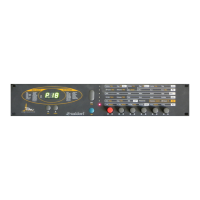User’s Manual Pulse • PulsePlus
33
* Unless stated otherwise, these examples apply to a positive value for "Amount" (01...63).
Table 4: Examples of modulation assignments (continued)
No Name Route the ModSource to ...* ... to archieve the
following effect:
9 Keytrack LFO1 Speed The speed of LFO1 is
determined by the MIDI
notes (increase or
decrease). An Amount of
+45 is equivalent to a
ratio of 1:1 between the
LFO speed and a given
note.
10 Pitch Follow Cutoff Melodically tuned filter;
especially interesting at
high Resonance settings.
The filter frequency also
applies to portamento
effects.
11 Pitchbend Osc2 Pitch A Pitchbend range of 0
for sync or
crossmodulation sounds
produces interesting
tremolo and pitchbend
effects.
12 Modwheel Cutoff Opening/closing the filter
frequency.
Noise Level Adds noise to the signal.
Pulsewidth 1 or 2 Changes the pulsewidth.
13 Aftertouch Osc 1, 2 or 3 Level Use Aftertouch to
overdrive the oscillators.
This sound is similar to
the feedback produced by
an electric guitar.
Cutoff Opens the filter when you
press a key with more
pressure.
14 Breath Ctr. Volume Typical setting for sounds
that are played via the
Breath Controller.
15 Control X Resonance Changes the filter
resonance.

